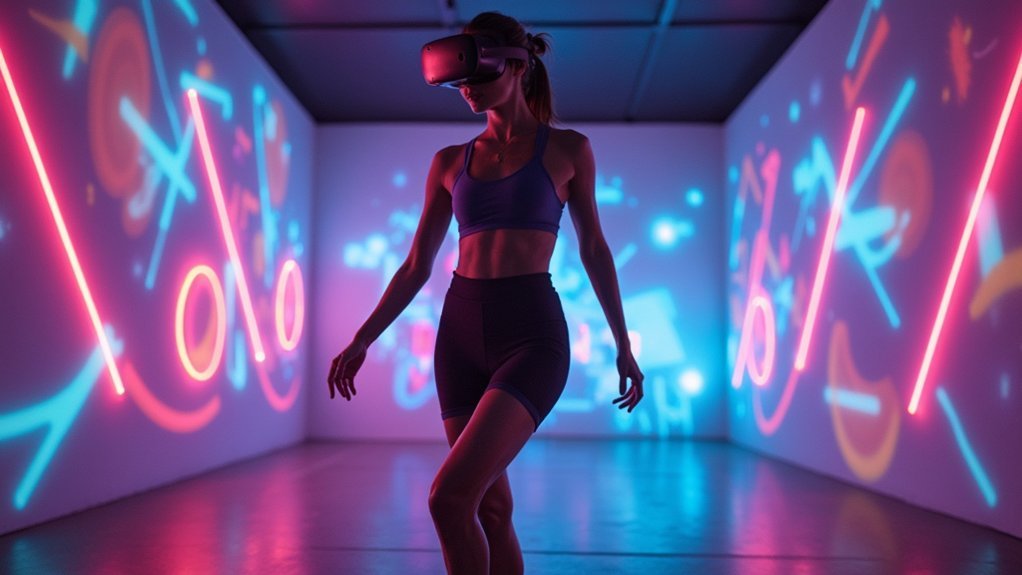When you increase your VR headset’s field of view, you’re fundamentally stretching the same number of pixels across a much larger visual area, which dramatically reduces pixel density. This creates fewer pixels per degree of vision, leading to visible gaps and compromised sharpness throughout your virtual experience. Additionally, wider FOV introduces optical distortions in your peripheral vision, causing blurred edges and focus quality issues that further degrade image clarity. Understanding these technical limitations can help you optimize your VR settings.
The Fundamental Tradeoff Between FOV and Pixel Density
When you increase a headset’s field of view, you’re fundamentally stretching the same number of pixels across a much larger visual area, which directly reduces pixel density and compromises your visual experience.
This creates an unavoidable mathematical relationship where wider FOV means fewer pixels per degree of vision.
Consider a headset with 100 pixels across its display. At 90 degrees FOV, you’ll get higher pixel density than the same 100 pixels stretched across 130 degrees.
The pixels become more spread out, creating visible gaps and reducing sharpness. Current VR headsets demonstrate this tradeoff clearly, typically offering 110-130 degrees FOV but delivering only 10-15 pixels per degree.
You’re basically choosing between immersive peripheral vision and crisp central detail.
How Pixel Distribution Changes With Wider FOV
As you expand your headset’s field of view, the pixel distribution becomes increasingly uneven across your visual field. Your available resolution gets stretched over a larger area, creating a dilution effect that reduces pixels per degree throughout the display.
Wider VR fields of view sacrifice pixel density, spreading limited resolution across expanded visual real estate and diminishing overall image sharpness.
When you switch to a wider field of view, you’ll notice several distribution changes:
- Central clarity degradation – Sharp details in your direct vision become less defined as pixels spread thinner.
- Edge blur amplification – Peripheral areas suffer from optical distortions and reduced effective resolution.
- Screen door intensification – Individual pixels become more visible as they cover larger visual angles.
- Detail compression – Fine textures and text appear less crisp due to lower pixel density.
- Immersion vs. sharpness conflict – Enhanced presence comes at the cost of visual fidelity.
This redistribution fundamentally alters your visual experience in VR environments.
Technical Limitations of Current VR Display Technology

Despite significant advances in VR technology, current display systems face fundamental constraints that directly impact visual quality at wider fields of view.
When you’re experiencing a wider view, your headset’s magnification optics struggle to maintain image integrity across the expanded area. These optics create distortions and optical artifacts that become increasingly problematic as FOV expands.
You’ll notice the screen-door effect intensifies with wider viewing angles because existing display technology can’t pack enough pixels into the available space.
Current headsets operate at 10-15 pixels per degree, which isn’t sufficient for maintaining visual clarity across expansive fields of view.
Even promising 3Kx3K displays won’t solve this limitation without corresponding advances in GPU processing power and revolutionary optical design improvements that current manufacturing capabilities can’t yet deliver.
Angular Resolution and Its Impact on Visual Sharpness
When you increase your VR headset’s field of view, you’re spreading the same number of pixels across a wider visual area, which directly reduces the pixels per degree (PPD) that reach your eyes.
This fundamental relationship means you’ll experience less visual sharpness as your headset tries to cover more territory with the same pixel budget.
The most noticeable consequence you’ll encounter is the screen door effect, where the gaps between individual pixels become increasingly visible and distracting.
Pixels Per Degree Fundamentals
Sharpness in virtual reality hinges on a critical measurement called Pixels Per Degree (PPD), which determines how many individual pixels occupy each degree of your visual field.
This metric directly influences your perceived visual clarity and determines whether you’ll experience crisp details or notice the dreaded screen-door effect.
Think of PPD as your VR headset’s resolution density:
- Text readability – Higher PPD lets you read fine print without squinting
- Object edges – Sharp boundaries instead of jagged, pixelated lines
- Distant details – Clear mountain textures rather than blurry smudges
- UI elements – Crisp menu buttons and interface components
- Facial features – Detailed character expressions in social VR
When pixels per eye remain constant but FOV expands, those same pixels stretch across more visual degrees, reducing PPD and compromising visual clarity throughout your virtual experience.
Screen Door Effect
As your VR headset’s field of view expands, you’ll notice something unsettling happening to your visual experience—individual pixels become increasingly visible, creating what’s known as the screen door effect. This grid-like pattern emerges because a wider FOV spreads the same pixel density across a broader area, reducing pixels per degree and overall sharpness.
| FOV Setting | Screen Door Effect | Visual Clarity | PPD Impact |
|---|---|---|---|
| Narrow (90°) | Minimal | High | Strong |
| Standard (110°) | Moderate | Good | Balanced |
| Wide (130°) | Noticeable | Reduced | Weakened |
| Ultra-wide (150°) | Prominent | Poor | Severely reduced |
When FOV is prioritized over resolution, you’ll experience noticeable pixelation and artifacts. The trade-off becomes particularly apparent at your vision’s periphery, where reduced angular resolution affects fine detail perception.
Optical Distortion Effects at Wider Viewing Angles

When you expand your VR headset’s field of view, you’ll encounter several optical distortion effects that compromise image quality at the edges of your visual field.
Your peripheral vision suffers from lens aberrations that bend and warp light rays as they enter at steeper angles, creating noticeable distortion artifacts along the display’s borders.
This focus quality degradation becomes increasingly pronounced as manufacturers push FOV boundaries, forcing your eyes to work harder to process the compromised visual information at the periphery.
Peripheral Lens Aberrations
While VR headsets push for increasingly wider fields of view, peripheral lens aberrations create a fundamental optical challenge that directly undermines visual clarity.
When light rays enter your headset’s lens from wider angles, they bend unevenly, causing distortions that compromise your peripheral vision.
These optical imperfections manifest as:
- Blurred edges that make distant objects appear fuzzy
- Chromatic aberration creating rainbow-like color fringing
- Visual artifacts that break immersion during gameplay
- Difficulty focusing on objects near your field boundaries
- Compromised depth perception in peripheral areas
Peripheral lens aberrations force manufacturers into difficult trade-offs between FOV width and optical clarity.
Even with advanced lens materials and sophisticated designs, achieving perfect visual fidelity across an expanded field remains elusive, directly impacting your VR experience quality.
Edge Distortion Artifacts
Beyond the blurring and color fringing that plague peripheral vision, edge distortion artifacts present an even more disruptive challenge to your VR experience.
When you’re using a headset with wider FOV settings, the lenses must stretch images across greater angles, creating inconsistent pixel density throughout your display. This stretching produces a distinctive “fish-eye” effect where straight lines appear curved, particularly noticeable at the edges of your vision.
You’ll find that these geometric distortions make it difficult to discern details in your peripheral view, directly compromising visual clarity.
The wider your headset’s FOV, the more pronounced these edge distortion artifacts become. This creates a fundamental tension between achieving immersive wide-angle viewing and maintaining sharp, accurate visuals across your entire field of vision.
Focus Quality Degradation
As your VR headset’s field of view expands, the optical systems struggle to maintain consistent focus quality across the entire viewing plane.
Wider FOV creates inherent challenges for lens design, forcing compromises that directly impact visual clarity throughout your peripheral vision.
The degradation manifests in several noticeable ways:
- Sharp center images gradually blur toward edges, creating an uneven focus gradient
- Text becomes increasingly difficult to read as you look away from the display center
- Fine details dissolve into pixelated masses at extreme viewing angles
- Chromatic aberration introduces color fringing that breaks object boundaries
- Barrel distortion warps straight lines into curves, disrupting spatial perception
Your eyes naturally compensate for some deficiencies, but the optical limitations become apparent during detail-intensive tasks, making wider FOV a double-edged sword for immersive experiences.
Rendering Performance Constraints With Expanded FOV
When you expand your field of view, your GPU faces markedly increased computational demands that directly impact visual quality.
Rendering more pixels across a broader area strains your graphics processing power, forcing compromises that reduce overall image fidelity. Your system must work harder to maintain consistent frame rates, often requiring you to lower resolution settings to compensate for the expanded FOV’s computational burden.
This performance bottleneck creates a cascading effect on visual clarity.
You’ll notice decreased pixel density as your GPU struggles to populate the wider viewing area with sufficient detail. The increased workload can introduce rendering artifacts and optical distortions that weren’t present at narrower field settings.
Ultimately, your pursuit of enhanced peripheral awareness comes at the cost of sharp, detailed imagery throughout your expanded visual field.
Screen Door Effect Amplification in Wide FOV Settings
When you increase your FOV settings, you’re fundamentally stretching the same number of pixels across a much larger visual area, which dramatically reduces pixel density and makes the gaps between individual pixels more noticeable.
This magnification effect transforms what might’ve been barely perceptible inter-pixel spacing into clearly visible grid lines that create the dreaded screen-door appearance.
You’ll find that this amplified screen-door effect becomes particularly distracting because your eyes can now easily detect the individual pixel boundaries that were previously masked by tighter pixel arrangements.
Pixel Density Distribution
Picture how pixels spread across your expanded field of view:
- Individual pixels become larger and more noticeable as they cover greater angular distances.
- Sharp text transforms into blurry, pixelated characters that strain your eyes.
- Fine details in textures dissolve into blocky, undefined shapes.
- Smooth curves appear jagged with visible stepping artifacts.
- Overall image quality degrades from crisp to soft and unclear.
This distribution challenge means you’ll always face the decision between immersive width and sharp detail.
Inter-Pixel Gap Visibility
Beyond the pixel density problem lies an even more distracting visual artifact: the screen door effect becomes dramatically more pronounced as your FOV expands.
When you’re using a wider FOV, those gaps between pixels become glaringly obvious because the same display must stretch across a larger visual area. Your eye becomes more sensitive to these inter-pixel gaps at greater viewing angles, making the screen door pattern impossible to ignore.
The reduced pixel density in wide FOV settings amplifies this effect considerably.
You’ll notice that fine details and text become harder to read as the visible gaps between pixels create a mesh-like overlay across your entire view. This pixelation compromises your ability to discern intricate visuals, turning what should be immersive experiences into frustratingly artifact-riddled displays.
Magnification Effect Impact
As your headset’s field of view expands, it fundamentally magnifies everything on the display—including those problematic inter-pixel gaps that create the screen door effect.
This magnification effect transforms minor visual imperfections into glaring distractions that compromise your overall visual clarity.
When FOV increases, you’re effectively zooming into the display, making every pixel appear larger and more defined. This creates several noticeable issues:
- Black grid lines between pixels become thick, dark barriers across your vision
- Individual pixel boundaries turn into prominent rectangular outlines
- Color gradients appear jagged and steplike rather than smooth
- Text becomes chunky and difficult to read at standard sizes
- Fine details dissolve into blocky, pixelated representations
The wider perspective forces your eyes to work harder, constantly fighting against these amplified visual artifacts that wouldn’t be problematic in narrower fields of view.
Peripheral Vision Quality Vs Central Visual Acuity
When you examine how your visual system processes information across different areas of your field of view, you’ll discover a fundamental trade-off between peripheral coverage and central sharpness.
Your central visual acuity naturally provides the highest detail resolution, while your peripheral awareness handles motion detection and spatial orientation with considerably less clarity.
Your eyes excel at sharp central detail but sacrifice clarity for broad peripheral motion detection and spatial awareness.
This biological limitation becomes problematic with wider FOVs because you’re fundamentally asking your visual system to process detailed information across areas where it’s least equipped to do so.
Your eyes can’t maintain sharp focus beyond the central 2-3 degrees of vision, making expanded viewing areas counterproductive for clarity-dependent tasks.
Consequently, wider FOVs force you to rely more heavily on peripheral vision, which inherently compromises the overall visual fidelity you experience.
Hardware Engineering Challenges for High FOV Displays
While your visual system imposes biological constraints on wide FOV clarity, the hardware itself presents equally formidable obstacles.
VR engineers face complex trade-offs when designing displays that balance FOV with visual clarity. Current headsets stretch limited pixels across wider viewing angles, creating inevitable compromises.
Key engineering challenges include:
- Pixel density dilution – spreading 1080p resolution across 110-130 degree FOV reduces pixels per degree
- Screen door effect – visible gaps between pixels become more pronounced at wider angles
- Optical distortion – lenses required for wide FOV introduce artifacts that degrade image quality
- Refresh rate limitations – maintaining smooth performance while processing expanded visual data
- Heat management – higher-resolution displays needed for wide FOV clarity generate excessive thermal output
You’re fundamentally asking current display technology to perform beyond its ideal parameters.
Real-World Testing Results Comparing FOV and Clarity
Laboratory analysis confirms what hardware limitations predict: expanding your field of view consistently degrades visual clarity across real-world VR applications.
When you test different FOV settings in SteamVR Home, you’ll notice reduced sharpness and clarity at wider angles, particularly in high-resolution environments. Text readability suffers most dramatically—normal FOV gives you crisp, legible characters while larger settings blur important details.
You’ll experience increased screen-door effect and peripheral blur as FOV expands, creating an overall quality decrease during gameplay.
Game-specific results vary considerably: War Dust becomes noticeably blurry with large FOV settings, while Assetto Corsa maintains reasonable visual clarity.
Dynamic resolution adjustments complicate testing, making it challenging to isolate FOV’s direct impact on visual fidelity during real-world usage scenarios.
Frequently Asked Questions
Does Higher FOV Mean You See More?
Yes, you’ll see more of the game world with higher FOV since it expands your viewing angle. You’ll gain better peripheral vision and situational awareness, letting you spot enemies and objects outside your normal field of view.
Does Increasing FOV Reduce Performance?
Yes, increasing FOV reduces performance because your GPU must render more pixels across the wider viewing angle. You’ll likely experience lower frame rates and potential input lag on less powerful systems.
Why Does Focal Length Affect Field of View?
When you change focal length, you’re altering the distance between the lens and sensor. Shorter focal lengths capture wider angles, giving you broader FOV, while longer focal lengths narrow your view considerably.
What Does Changing FOV Do?
When you change FOV, you’re adjusting how much of the virtual environment you can see at once. You’ll gain broader peripheral vision but lose pixel density, making objects appear less sharp and detailed.





Leave a Reply